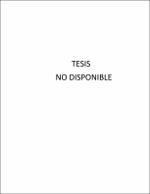Prevalencia de trastornos temporomandibulares y su relación con la perdida de soporte oclusal posterior en adulto

View/Open
Download
(application/pdf: 80.88Kb)
(application/pdf: 80.88Kb)
Date
2017Author(s)
Herrera Rodriguez, Pool Mariano
Metadata
Show full item recordAbstract
Determinar la relación entre la prevalencia de Trastornos
Temporomandibulares y la pérdida de soporte oclusal posterior en pacientes adultos
atendidos en la Clínica Estomatológica de la universidad Privada Antenor Orrego de
Trujillo durante el periodo 2016-I.
Materiales y método: La muestra de estudio estuvo constituida por 105 pacientes
mayores de 25 años de edad que acuden al servicio de la clínica estomatológica de la
Universidad Privada Antenor Orrego de Trujillo, en el periodo 2016-I. Los pacientes
fueron examinados mediante interrogatorio y examen clínico oral, mediante la Ficha
confeccionada por el investigador basada en el índice de Helkimo (ver anexo 1 y 2).
Resultados: Se encontró que los pacientes con pérdida de soporte oclusal posterior
estudiados presentan mayor severidad de trastornos temporomandibulares a
comparación de los pacientes sin pérdida de soporte oclusal posterior, en cambio en la
presencia de trastornos temporomandibulares no hubo diferencia significativa. En el
sexo no hubo diferencia significativa y el grupo etario con más afectados de severidad
de trastornos temporomandibulares fue el de 56 años a más. Se encontró que hubo una
mayor presencia de trastornos temporomandibulares leves. Se utilizó el análisis
estadístico de Chi cuadrado y el análisis estadístico reducido de Fisher, concluyendo
que existe una asociación estadísticamente significativa (p<0.001) entre prevalencia de
Trastornos Temporomandibulares y Pérdida de Soporte Oclusal Posterior y entre
severidad de Trastornos Temporomandibulares y Pérdida de Soporte Oclusal Posterior.
Conclusión: Existe una asociación estadísticamente significativa (p < 0.001) entre
prevalencia de trastornos temporomandibulares y pérdida de soporte oclusal posterior y
entre severidad de trastornos temporomandibulares y pérdida de soporte oclusal
posterior, concluyéndose que la severidad de Trastornos Temporomandibulares y la
Pérdida de Soporte Oclusal Posterior son dependientes. Determine the relationship between the prevalence of temporomandibular
disorders and loss of posterior occlusal support in adult patients treated at the
Stomatology Clinic Private University Antenor Orrego of Trujillo during the period
2016-I.
Materials and Methods: The study sample consisted of 105 patients over 25 years of
age who come to serve the dental clinic of the Private University Antenor Orrego of
Trujillo, in the period 2016-I. Patients were examined by clinical examination and oral
examination, by the sheet drawn up by the investigator based on the index Helkimo (see
Annex 1 and 2).
Result: It was found that patients with loss of posterior occlusal support studied show
greater severity of temporomandibular disorders compared to patients without loss of
posterior occlusal support, while in the presence of temporomandibular disorders was
no significant difference. Sex was no significant difference and the most affected age
group with TMD severity was 56 years later. It was found that there was a greater
presence of mild temporomandibular disorders. the statistical analysis Chi square and
reduced Fisher statistical analysis was used, concluding that there is a statistically
significant association (p <0.001) between prevalence of Temporomandibular Disorders
and Loss Support Oclusal Posterior and between severity of Temporomandibular
Disorders and Loss Oclusal Support Rear.
Conclusion: There is a statistically significant association (p <0.001) between
prevalence of temporomandibular disorders and loss of occlusal support back and
between severity of temporomandibular disorders and loss of occlusal support later,
concluding that the severity of Temporomandibular Disorders and Loss Support Oclusal
Posterior are dependent .
Collections
- Estomatología [687]

